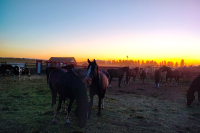Where martins hang
 Purple martin “scouts” are some of the earliest harbingers of spring. I recorded one in February at Black Bayou Lake National Wildlife Refuge in Louisiana during last year’s Great Backyard Bird Count, and it’s not uncommon for them to show up in Florida in January.
Purple martin “scouts” are some of the earliest harbingers of spring. I recorded one in February at Black Bayou Lake National Wildlife Refuge in Louisiana during last year’s Great Backyard Bird Count, and it’s not uncommon for them to show up in Florida in January.
Global warming imperils Golden-winged warbler
 The steady decline of the Golden-winged Warbler on the Southern Appalachian landscape is a trend that not only threatens the future of the bird in Western North Carolina but also puts in peril the species as whole.
The steady decline of the Golden-winged Warbler on the Southern Appalachian landscape is a trend that not only threatens the future of the bird in Western North Carolina but also puts in peril the species as whole.
During the past century, it has experienced one of the most precipitous population falls of nearly any other songbird species. Brought on by habitat loss and interbreeding with a more dominant species of warbler, less than 500,000 exist in the United States.
Carolina birder video bombed
 Carolina birder Matt Daw from Raleigh was videoing a least bittern last week as it foraged at Bosque Del Apache National Wildlife Refuge in New Mexico. In an interview, Daw said he was looking through the viewfinder at the bittern when suddenly an interloper sauntered by behind the bittern.
Carolina birder Matt Daw from Raleigh was videoing a least bittern last week as it foraged at Bosque Del Apache National Wildlife Refuge in New Mexico. In an interview, Daw said he was looking through the viewfinder at the bittern when suddenly an interloper sauntered by behind the bittern.
Audobon Society, here I come
Maybe someone heard my plea.
For the last two weekends, the rain, for the most part, has stayed away, giving us at least one nice day without a drop to enjoy some time outdoors. And after having my first attempt to go birding cancelled because of the weather, I was looking forward Saturday to finding out why others enjoyed the hobby so much.
A hangover of hoverers
 As we turn to bask in the full glow of the summer sun, mornings begin to heat up quickly. As they heat, they become quieter.
As we turn to bask in the full glow of the summer sun, mornings begin to heat up quickly. As they heat, they become quieter.
A record-breaking weekend of birding
 Last week, we set the stage for the 29th annual Great Smoky Mountains Birding Expedition (GSMBE). The group starts at 9 a.m. at George and Elizabeth Ellison’s office/studio in downtown Bryson City. I know, birders out there are rolling their eyes — to start a count at 9 a.m. is like missing half the day, but there are caveats.
Last week, we set the stage for the 29th annual Great Smoky Mountains Birding Expedition (GSMBE). The group starts at 9 a.m. at George and Elizabeth Ellison’s office/studio in downtown Bryson City. I know, birders out there are rolling their eyes — to start a count at 9 a.m. is like missing half the day, but there are caveats.
Identifying birds
 Although bird identification can be perplexing — baffling at times for even the most accomplished birders — the principles of identification are relatively simple. We recognize birds by their visual appearances and by their vocalizations.
Although bird identification can be perplexing — baffling at times for even the most accomplished birders — the principles of identification are relatively simple. We recognize birds by their visual appearances and by their vocalizations.
A record-breaking weekend (part one)
 What could be more fun than a weekend of fellowship and great birding? Maybe setting a new record for total number of species recorded during the annual Great Smoky Mountains Birding Expedition?
What could be more fun than a weekend of fellowship and great birding? Maybe setting a new record for total number of species recorded during the annual Great Smoky Mountains Birding Expedition?
Some scarlet tanagers are orange
 Last Saturday, I led a bird identification workshop for the Smoky Mountain Field School. We started out in the morning in a residential area (Minot Park) in Gatlinburg and worked our way into the higher elevations of the national park by late afternoon. The weather at Newfound Gap was perfectly awful: wind, rain, fog, cold, you name it. But it was a good group and we did OK.
Last Saturday, I led a bird identification workshop for the Smoky Mountain Field School. We started out in the morning in a residential area (Minot Park) in Gatlinburg and worked our way into the higher elevations of the national park by late afternoon. The weather at Newfound Gap was perfectly awful: wind, rain, fog, cold, you name it. But it was a good group and we did OK.
Cliff swallows return
 That’s the news. Our common breeding swallows have always been purple martins, barn swallows, and northern rough-winged swallows. To a lesser extent, tree swallows also breed here, where there are suitable tree cavities or boxes. Cliff swallows are another matter.
That’s the news. Our common breeding swallows have always been purple martins, barn swallows, and northern rough-winged swallows. To a lesser extent, tree swallows also breed here, where there are suitable tree cavities or boxes. Cliff swallows are another matter.













